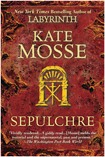By Sheri Harshberger
I love to read. I've been reading since I was 2 years old, and I’ve always enjoyed it. Unfortunately, I rarely have the time to read fiction anymore, so when I do read something, I want it to be worthy of the time I spend reading it. Sepulchre, by Kate Mosse, did not disappoint me.
I liked everything about it, with one exception that I will get to later. There are actually two stories playing out in this book: one is set in 1891, and the other is set in 2007. Mosse expertly shifts from one plotline to the other at key, cliff-hanging points, leaving the reader in suspense at the break in one story, but also excited to find out what is happening in the other story.
The story that is set in 1891 introduces us to Leonie Vernier and her family -- her brother, Anatole, her mother, Marguerite, and her brother's friend, Claude Debussy, all members of the Parisian upper class. Circumstances cause Leonie and her brother to hurry out of town, hiding their tracks to their true destination, a mysterious and lonely estate in the southwest of France. The estate is home to a beautiful widowed aunt, and local superstitions involving demons, Tarot cards, and an ancient Visigoth chapel surround the place.
In the other plotline, set in 2007, we find a young woman scholar, Meredith Martin, working on a biography of Debussy. She is intrigued by a photo of an unidentified man that is associated in some way with both Debussy and her own biological family. During her research of Debussy and his associates in Paris, she receives an intriguing Tarot reading and a deck of Tarot cards that haunts her and subsequently changes the focus of her research. She begins investigating her own mysterious past, as something insane and evil pursues her to an ultimate showdown in the ruins of an ancient chapel on the grounds of an ancient estate turned hotel.
I would never have guessed that this book was 565 pages! I read it in a day and a half! It was addictive. The story in the historical setting gives just enough detail for someone who is not a history buff (like me) to get a good context without being boring.
One of the real high points for me was the slight disconnection between the stories. It added to the realism. It was interesting to see the heroine in 2007 make assumptions and guesses about what happened in 1891 as she comes across the clues. She isn't necessarily spot-on with every detail—which is what you would expect in real life.
Another high point, a gift to the Tarot community really, was the Tarot reading depicted in the story. It was mysterious and modern, not gimmicky or stereotypical as Tarot readings and readers are usually portrayed in novels, television, and movies. As a Tarot reader myself, I was very thankful for that. I, or any one of my fellow professional readers, could have been that reader and given that reading.
Now for the disappointment. It doesn't have anything to do with the story or the book itself. The story introduces the reader to the Vernier Tarot, which is a fictional Tarot deck created only for the book. Unfortunately, only the few cards identified in the reading described in the story were created and included in the book. Many Tarot readers enjoy collecting decks, and it would have been a real bonus if the publisher had actually made this deck, either as a full 78-card deck or as a 22-card Majors only deck. Although the lack of a real life Vernier Tarot might leave cardophiles like me wanting more, all in all, Kate Mosse’s Sepulchre is a very satisfying read.

